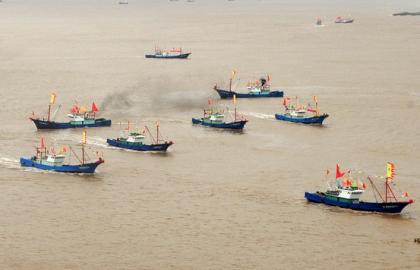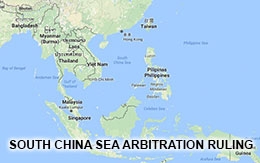China's Maritime Militia: A Legal Point of View
The international community should better understand how potential aggressors can leverage the ambiguity for low-level armed attack or aggression and be prepared to clearly identify it as an internationally wrongful act.

Introduction
State traditionally mobilized their merchant vessels to support armed forces during armed conflict.[1] In the past, merchant vessels, including fishing boats such as trawlers, drifters and whalers, have been requisitioned, commandeered or purchased for navy or military use.[2] For example, during the world wars, the United Kingdom converted numerous trawlers into armed naval trawlers[3] and their duties were mainly to conduct anti-submarine warfare and minesweeping missions. These mobilizations were normally conducted at the outbreak of war.[4]Today China’s mobilization regime for civilian ships, including a maritime militia, departs from earlier precedents. China has mobilized fishing boats and fishermen in peace time and possibly will mobilize them in wartime in a peculiar manner[5]. China uses fishing boats and fishermen to protect China’s maritime interests and to support the People’s Liberation Army (PLA), and law enforcement agencies. This paper discusses the legal status of the maritime militia and their fishing boats by focusing on their legal status under jus ad bellum, the law governing the use of armed force, and jus in bello, law of armed conflict.
Cases
In March 2009, Chinese vessels including two fishing trawlers harassed the USNS Impeccable in the South China Sea. It is estimated that Maritime Militia operated two of the five fishing vessels and trawlers that intercepted and blocked the unarmed survey ship. China has also used maritime militia for occupying islands and reefs in the South China Sea, ferrying supplies and providing other logistics support for China’s reclamation and occupation.
There were also cases in the East China Sea where China has deployed the maritime militia. In April 1978, for example, some 200 Chinese fishing boats approached the vicinity to the Senkaku Islands. Dozens of the fishing vessels entered into the Japanese territorial sea around the islands. Some of the fishing boats were observed with machine guns mounted on their decks. This incident appears to involve the Chinese Maritime Militia. According to a member of Ministry of Foreign Affairs of Japan, the Chinese fishing flotilla had received communication directions from two Chinese Naval bases, Amoy in Fujian Province, and Yantai in Shandong Province[6].
In August 2016, about 230 fishing boats approached the Senkaku Islands together with Chinese Coast Guard vessels, and eight Chinese fishing boats and Coast Guard ships repeatedly entered the Japanese territorial sea. The Japanese government sent its Coast Guard to the area and protested China’s violation of Japan’s sovereignty.
Legal status of the Maritime Militia in “peacetime” (Jus ad bellum)
In order to make sure the legal status of the maritime militia, we have to know what the militia is. There is no international standard or definition of a militia, however, the following is a general definition:
“[A] military or paramilitary unit or group, which is not composed of professional soldiers but of regular citizens who are trained for their military duty in cases of emergency or as reserve forces to support regular troops.[7]”
From the perspective of international law, the main issue related to the militia is whether their members have the status of lawful combatants.[8] Article 1 of the Hague Land War Regulations of 1907 provides that the laws, rights, and duties of war apply not only to armies, but also to militia and volunteer corps when they satisfy specific conditions such as having a fixed distinctive emblem.[9] Furthermore, “[i]n countries where militia or volunteer corps constitute the army, or form part of it, they are included under the denomination ‘army’.” Therefore, whether the militia is integrated into the regular forces of a belligerent or not is a matter of domestic law. China’s domestic laws provide for militia.
Article 55 of the Constitution[10] states:
It is the sacred obligation of every citizen of the People's Republic of China to defend the motherland and resist aggression. It is the honorable duty of citizens of the People's Republic of China to perform military service and join the militia in accordance with the law.
Likewise, Article 22 of the National Defense Law[11] stipulates that:
The armed forces of the People’s Republic of China are composed of the active and reserve forces of the Chinese People’s Liberation Army, the Chinese People’s Armed Police Force and the Militia (emphasis added).
Therefore, China’s militia is an integral part of the armed forces of the nation. National Defense Law Article 22 also provides that the militia, under the command of military organs, shoulders the task of preparations for armed conflict and defense operations and assists in maintaining public order. The maritime militia is deployed to: (a) support for the PLA Navy (PLAN) including defense operations, (b) cooperation with law enforcement agencies including sabotage and intelligence operations and (c) China’s maritime interests’ protection activities including daily fishing and surveillance activities[12].
A peculiarity of China’s maritime militia is its ambiguity. Maritime militia at the time of operations in the South China Sea and in the East China Sea, they disguised as private fishermen.[13] Thus a problem for neighboring countries is the difficulty of identifying whether the vessels contain mere private fishermen or fishermen as China’s government proxies.
A concern in the East China Sea is infringement on the Senkaku Islands, Japanese territory off the coast of Okinawa. One scenario envisions fishing boats with apparent fishermen as crew, actually operating as a maritime militia or fishermen under control of a maritime militia who swarm land and occupy the Senkaku Islands.[14] In such case, what would be the status of infringement on Japan’s territory by armed personnel disguised as private fishermen conducting an operation as government proxies? Would their conduct be a crime or an armed attack? In the case of the landing upon the Senkaku Islands by an armed group disguised as private fishermen, it is assessed they would be militia or armed groups under control of a state. What is the nature of this infringement? The UN General Assembly “Resolution on the definition of aggression” (1974), Annex, Article 3, defines “aggression” as:
(a) The invasion or attack by the armed forces of a State of the territory of another State, or any military occupation, However, temporary, resulting from such invasion or attack, or any annexation by the use of force of the territory of another State or part of thereof;
(g) The sending by or on behalf of a State of armed bands, groups, irregulars or mercenaries, which carry out acts of armed force against another State of such gravity as to amount to the acts listed above, or its substantial involvement therein.
If the forces are militia, they are in fact an armed force of China and the infringement comes under (a), invasion or attack by the armed forces. Even if they are not assessed as maritime militia but are members of an armed group under control of a state, the infringement falls within (g) of the definition, and that is also aggression or an armed attack as well.
Legal status of the Maritime Militia during wartime (Jus in bello)
If it is assessed they are militia during wartime, what is the status of maritime militia or their vessels under the law of armed conflict? China’s maritime militia is part of the armed forces of China. If they land on foreign islands or territory, they are subject to the law of land warfare such as carrying arms openly, and having a fixed distinctive emblem.[15]According to Article 44 (3) of the Additional Protocol I to the Geneva Conventions[16], there is a situation that a person shall retain his status as a combatant while carrying his weapon openly without the distinctive emblem. However,such situation is limited only to armed conflict in an occupied area or in the exercise of the right of self-determination.[17] Thus, if maritime militia land on foreign territory while wearing civilian clothes such as shorts and t-shirts, they are not lawful combatants.
The “uniform rule” does not apply to warfare at sea. The law of armed conflict at sea does not consider the clothes of crew members because the ship, not the individuals on board, is the target. The law of naval warfare assesses the legal status of warships, auxiliary naval vessels and merchant vessels on the status of the ship. For example, the definition of a warship is set forth in Article 29 of the United Nations Convention on the Law of the Sea (UNCLOS)[18] which reflects customary international law.[19] Article 29 states:
For the purposes of this Convention, “warship” means a ship belonging to the armed forces of a State bearing the external marks distinguishing such ships of its nationality, under the command of an officer, duly commissioned by the government of the State and whose name appears in the appropriate service list or its equivalent, and manned by a crew which is under regular armed forces discipline.
Therefore, if the ships of the maritime militia meet the four conditions in Article 29, it may be characterized as warship. These conditions are: (a) belonging to the armed forces of a State, (b) bearing external marks, (c) under the command of an officer, and (d) manned by a crew which is under regular armed forces discipline. Yet China’s maritime militia employs fishing boats that do not bear any external marks distinguishing used by warships. Supposing that they convert their fishing boats into warships, they would have to announce the conversion in the list of warships based on the Hague Convention VII of 1907, Article 6[20] which is recognized as customary international law.[21] The treaty states:
A belligerent who converts a merchant ship into a war-ship must, as soon as possible, announce such conversion in the list of war-ships.
If these conditions are not satisfied by the maritime militia’s fishing boat, it cannot be categorized as a warship and instead would be an auxiliary naval vessel. The auxiliary vessel is “a vessel, other than warship, that is owned by or under the exclusive control of the armed forces of a State and used for the time being on government non-commercial service.”[22] Both warships and auxiliary vessels are military objectives under the law of naval warfare.[23] However, if we cannot identify that these vessels are mobilized maritime militia, then they would be treated as mere enemy merchant vessels and the question of whether they are military objectives or not is a separate assessment based on their behavior such as engaging in belligerent acts, acting as an auxiliary to an enemy’s armed forces, assisting the enemy’s intelligence gathering system, or in some other manner integrating into the enemy fleet.
Even if these fishing boats are not assessed as military objectives, belligerents can seize them and they are subjects for adjudication as prizes.[24] In that case, it must be considered whether the fishing boat is a vessel protected from capture in the Hague Convention XI of 1907,[25] which is recognized as customary international law. Article 3 of that treaty states:
Vessels used exclusively for fishing along the coast or small boats employed in local trade are exempt from capture, as well as their appliances riggings, tackle, and cargo.
They cease to be exempt as soon as they take any part whatever in hostilities.
The contracting Powers agree not to take advantage of the harmless character of the said vessels in order to use them for military purposes while preserving their peaceful appearance.
If a fishing boat of the maritime militia is a small coastal fishing vessel engaging in local fishing for earning daily food, the fishing boat may be subject to protection[26]. However normally fishing boats of maritime militia are ocean-going trawlers and they operate in a deep-sea area which is more than 100 nautical miles from mainland of China. San Remo Manual paragraph 47. 47 says “[t]he immunity applies to fishing vessels that are operating near the coast, which does not mean that they have to be right next to the coast but can operate several miles offshore”. In other words, limits of fishing operation area of the protected small coastal fishing vessel are several miles offshore. Therefore, most fishing boats of the maritime militia are not protected under the exception for small coastal fishing vessels.
There are three choices for selecting the legal status of the fishing boats of the maritime militia: a warship, an auxiliary vessel or an enemy merchant vessel. Auxiliary vessels and merchant vessels maintain the right of self-defense, however only a warship enjoys belligerent rights.[27] During World War II, for example, the United Kingdom requisitioned fishing trawlers, drifters and whalers for engaging anti-submarine warfare, mine warfare, and other patrol missions.[28] They were called navy trawlers or admiralty trawlers, but their legal status was warship belonging to the Royal Navy hoisting the white ensign (naval ensign). The crews were conscripted from fishing communities and under the command of skippers from the fishing fleet, who served as officers of the Royal Navy, or Royal Naval Reserve (RNR) to ensure naval discipline.[29] The Japanese Imperial Navy also mobilized more than one thousand fishing boats.[30] Their commanding officers were naval officers and they hoisted the navy ‘rising sun’ flag. These mobilized fishing boats were converted into submarine chasers, mine sweepers, surveillance boats etc. and they had the status of warship in the Imperial Japanese Navy.[31] On the one hand, the purpose of these mobilizations of fishing vessels by the United Kingdom and Japan was to provide backup assets to the regular naval fleeting a time of total war, as occurred during the two world wars.[32] On the other hand, in the case of China, the existence of the militia is derived from the theory of a ‘People’s War’ which is a kind of a system of general conscription or participation in war by an entire people, notwithstanding the scale of the war.[33] China also leverages the advantage of using maritime militia disguised as private fishermen and the ambiguity surrounding their status. Thus, the maritime militia’s vessels are mobilized clandestinely in the South China Sea and the East China Sea and may never be employed as warships with an announcement in wartime of their conversion from merchant vessels into warships based on the 1907 Hague Convention VII. Therefore, the status of vessels of the maritime militia appears to be that of auxiliary vessels.
Conclusion
Armed attack or aggression by armed groups disguised as fishermen or armed forces who use ships with ambiguous appearance is a form of legal warfare that makes a victim state hesitate to respond with the right of self-defense, particularly when the victim state seeks to avoid the false impression to the international community that it is unnecessarily escalating the situation into a full-scale international armed conflict. The international community should better understand how potential aggressors can leverage this kind of ambiguity for low-level armed attack or aggression and be prepared to clearly identify it as an internationally wrongful act. Clearing up the ambiguity or legal “fog” surrounding China’s maritime militia might deter it from even more overt aggression in the East China Sea and the South China Sea.
As a matter of jus in bello, vessels of the maritime militia disguised as fishing boats have the status of auxiliary vessels and therefore, they are military objectives. Like all naval auxiliaries, they do not enjoy belligerent rights in wartime, though they have the right of self-defense.[34] If these ships engage in attacks against enemy warships while feigning status as civilian fishing boats, it is a perfidy in violation of the law of naval warfare.[35]
Koki Sato is a faculty member of JMSDF (Japan Maritime Self-Defense Force) Command and Staff College, Operational Law Office.
The title is given by the editorial board.
Click here for pdf file
Notes
[1] W.T. Mallison, Jr. “Studies in the Law of Naval Warfare: Submarines in General and Limited Wars,” International Law Studies (1966), Naval War College, pp. 106-122 (explaining that Government of the United Kingdom controlled merchant vessels during WWI and WWII). Mitsuo Miyamoto, Taiheiyo Senso Ushinnawareta Nihonsenpaku No Kỉoku [Records of sunken Japanese vessels during WWII] (2009) p.3 (explaining that Imperial navy and Imperial army requisitioned about 60% of Japanese merchant fleet which was composed of 2529 vessels in the beginning of the war). David Brown, The Royal Navy and the Falklands War (1987) pp. 349-374 (showing Ships Taken Up from Trade [STUFT] and Royal Fleet Auxiliaries of United Kingdom and auxiliaries of Argentina during the Falklands War).
[2] H.W. Wilson, Battleships in action (1995) p.83, p.308 (explaining that United Kingdom created 462 trawlers and drifters in November 1914 during World War I). Mitsuo Miyamoto, note 1, p.4 (explaining that Japan converted trawlers, drifters and whalers into 124 mine sweepers, 265 submarine chasers and 407 picket boats). David Brown, The Royal Navy and the Falklands War, note1, p. 374 (listing three fishing vessels including “NARWAL” as ‘Spy Trawler’ whose mission is reconnaissance operations).
[3] Paul Lund and Harry Ludlam (1971), Trawlers Go to War, p.9.
[4] Id.P.9. Gabriella Venturini, 1907 Hague Convention VII, Commentary, N. Ronzitti, The of Naval Warfare – A Collection of Agreemnts and Documents with Commentaries, p. 125.
[5] National Defense Mobilization Law (2010), (providing policies of the national defense mobilization, “combining peacetime and wartime”; “combining civil and military,” and principle of “participation by the entire people”).
[6] Nobuyuki Sugimoto, Daichi no Hoko - Moto Shanghai Ryojigamita Chugoku – [ Roar of the Earth - Perspectives of China from a Former Consul General at Shanghai -] (2006), pp.56-64.
[7] Julia Gebhard, Militias, In: Worlfrum R. (ed.), Max Planck Encyclopedia of Public International Law, Vol. VII, Oxford University Press, Oxford, 2012, p.227.
[8] Id.
[9] “Regulations Respecting the Laws and Customs of War on Land, Annex to the Hague Convention IV Respecting the Laws and Customs of War on Land,” October 18, 1907.
[10] “Constitution of the People’s Republic of China,” 1982.
[11] “Law of the People’s Republic of China on National Defense,” 1997.
[12] Masaaki Yatsuzuka, “China’s Advance into the Sea and the Maritime Militia,” note 6.
[13] Conor M. Kennedy and Andrew S. Erickson, “China Maritime Report No. 1,” note 8, p.15 (citing China’s Militia 11 (2016) and explaining about photo which shows the high rank officers’ inspection of non-uniformed maritime militia personnel).
[14] Katsuya Yamamoto, “The East China Sea - Future Trends, Scenarios, and Responses -,” Andrew S. Erickson and Ryan D. Martinson ed. (2019), China’s Maritime Gray Zone Operations (2019), pp. 234-236, (estimating possible future action against the Senkaku Islands or sovereignty of Japan). Andrew S. Erickson and Conor M. Kennedy, Meet the Chinese Maritime Militia Waging a ‘People’s War at Sea’, Wall Street Journal, March 31, 2015, (explaining the role of maritime militia including “conducting island landings to declare sovereignty”), accessed March 10, 2020, http://www.andrewerickson.com/2015/03/meet-the-chinese-maritime-militia-waging-a-peoples-war-at-sea/.
[15] Regulations Respecting the Laws and Customs of War on Land, Annex to the Hague Convention IV Respecting the Laws and Customs of War on Land, October18, 1907.
Article 1, (providing conditions of belligerents).
[16] Protocol Additional to the Geneva Conventions of August 12, 1949, and relating to the Protection of Victims of International Armed Conflict (Protocol I), June 8, 1977.
[17] International Committee of the Red Cross, Commentary on the Additional Protocols of June 8, 1977 to the Geneva Convention of August 12, 1949, (1987) Article 44, 1698, pp. 529-531.
[18] United Nations Convention on the Law of the Sea,10 December 1982.
[19] Wolff Heintschel von Heinegg, “Warship,” in Worlfrum R. (ed.), Max Flanck Encyclopedia of Public International Law, Vol. X, pp. 790-802. Gabriella Venturini, 1907 Hague Convention VII, Commentary, note 4, p. 122.
[20] Hague Convention VII Relating to the Conversion of Merchant Ships into War-Ships,18 October 1907.
[21] Gabriella Venturini, “1907 Hague Convention VII,” Commentary, note 4, p. 122.
[22] International Institute of Humanitarian Law, San Remo Manual on International Law Applicable toArmed Conflicts at Sea (1995), 13 (h).
[23]Id. para. 65. U.S. Navy NWP 1-14/M/U.S. Marine Corps MCTP 11-10B/U.S. Coast Guard COMDTPUB P5800.7A, The Commander’s Handbook on The Law of Naval Operations, 2017 August ed., 8.6.1, Enemy Warships and Military Aircraft.
[24] San Remo Manual, Part V Measures Short of Attack: Interception, Visit, Search, Diversion and Capture, Preliminary remarks, p.187.
[25] Hague Convention XI Relative to Certain Restrictions with Regard to the Exercise of the Right of Capture in Naval War, October 18, 1907.
[26]An exception to seizure under prize law exists for fishing vessels that are coastal craft used solely for subsistence fishing. See Paquete Habana and Lola, The Paquete Habana; The Lola, 175 U.S. 677 (1900). See also San Remo Manual, para. 47.46, Note 31 and James Kraska and Michael Monti, “The Law of Naval Warfare and China’s Maritime Militia,” 91 Int’l L. Stud. U.S. Naval War College, 450 (2015), pp.458 - 465 (comprehensively analysis of the legal status of fishing vessels during armed conflict).
[27] San Remo Manual, note 31, para. 13.21.
[28] Paul Lund and Harry Ludlam, Trawlers go to war (1971), note 3, p.9.
[29] Id.
[30] Kenji Ouchi, Tatakau Nihon Gyosen [Fighting Japanese Fishing Boats] p.26.
[31] Id. P.65.
[32] Id. pp. 3-26. H.W. Wilson, Battleships in action, note 2, P. 308.
[33] Tomohide Murai, Senryakuron Taikei, 7, Moutaku To [Outline of Theory Of Strategies, Vol. 7, [Mao Tse-tung], (2004) p.116 (explaining difference between the People’s War and the Total War). James Kraska and Michael Monti, “The Law of Naval Warfare and China’s Maritime Militia,” note 35, pp.455 – 456, (describing the concept of the people’s war as the war doctrine in which civilian and military sectors are integrated). Dale C. Rielage and Austin M. Strange, “Is the Maritime Militia Prosecuting a People’s War at Sea?,” Andrew S. Erickson and Ryan D. Martinson ed. (2019), China’s Maritime Gray zone operations, p.40, (explaining that “[d]octrinally, people’s war broadly emphasizes security cooperation between military and civilian units” and “[o]perationally people’s war embraces a menu of specific guerrilla warfare tactics employed by Mao’s forces during World II and against the KMT”, Kuomintang, rivals during the civil war in China)).
[34] San Remo Manual, note 31, para. 13.21.
[35] Id. para. 111, 1977 Additional Protocol I to the Geneva Conventions of 12 August 1949, Article 37 Prohibition of Perfidy 1 (c).










